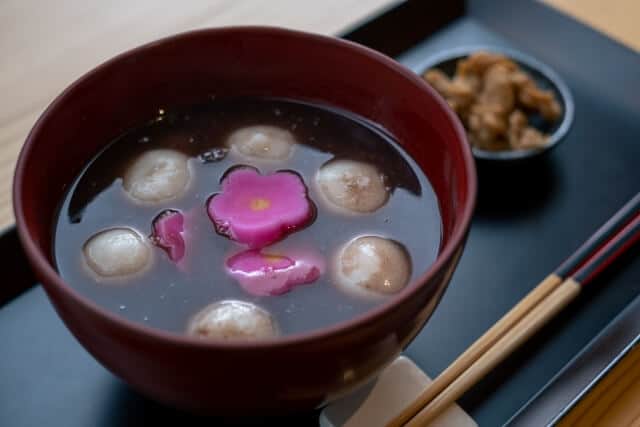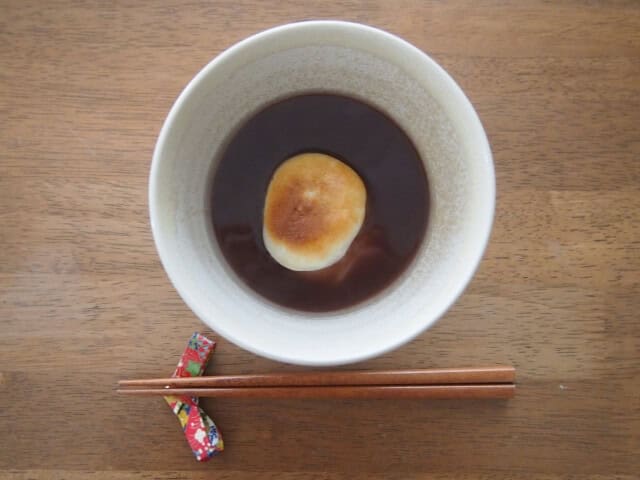In this article, we will explore the history of oshiruko, its regional variations, and the modern techniques that continue to make it a cherished treat today. Join us as we delve deeper into this delicious dessert and discover why oshiruko holds a special place in Japanese cuisine
What is Oshiruko?

Oshiruko (お汁粉) is a traditional Japanese sweet soup made from azuki beans (red beans) and sugar, often enjoyed as a warm dessert during the colder months. Locals typically served the soup with soft mochi (glutinous rice cake) or shiratama (small rice-flour dumplings). In the Kanto region of Japan, all types of sweet red bean soup are generally called shiruko, regardless of whether they are made with smooth, strained bean paste (koshian) or chunky bean paste (tsubuan). However, there are specific names for each: gozen shiruko refers to shiruko made with smooth bean paste, while inaka shiruko or ogura shiruko refers to the version made with chunky bean paste.
Difference between Zenzai and Oshiruko

The distinction between zenzai and oshiruko differs between the Kanto and Kansai regions of Japan. In Kanto, zenzai refers to a dessert without much liquid, served with mochi or shiratama, while oshiruko is a sweet soup with liquid. Oshiruko can further be classified into inaka shiruko (using chunky red bean paste) or gozen shiruko (using smooth bean paste), with square mochi commonly used. In contrast, in Kansai, zenzai is a thicker, bean-paste-based dessert with a hint of red bean paste, whileshiruko is smoother and liquid-based. Kansai often uses round mochi, highlighting a regional difference in preparation and naming.
Oshiruko in Kansai vs Kanto area
The discrepancy in the nomenclature of shiruko between Kansai and Kanto can be attributed primarily to the divergence in their historical genesis and the mechanisms of dissemination.
The Kansai region first developed the dish known as “Zenzai.” This dish evolved from “Jinzaimochi,” which people served at the “Jinzai Festival” in Izumo during the Muromachi period (1336-1573). This dish consisted of rice cakes in a soup with sweet bean paste. Subsequently, “Yoshiko” was accepted as a novel foodstuff introduced from Edo. This dish, which employs the use of koshi-an (sweet red bean paste), subsequently became distinguished from the extant “Zenzai” variety, characterised by the presence of grains of red bean paste.
Meanwhile, Yoshiko emerged in the Kanto region during the mid-Edo period. The preparation of “shiruko” involved the incorporation of dumplings into a soup base comprising boiled azuki bean flour and sugar. During the late Edo period, merchants opened specialized shiruko shops and offered two distinct varieties of this dish: “inaka shiruko” (red bean paste) and “gozen shiruko” (sweetened red bean paste). People in the Kanto region call both types “oshiruko,” and distinguish them by their sweetness levels.In contrast, in the Kansai region,
it was necessary to differentiate between the existing “zenzai” and the newly introduced “oshiruko.” In the Kanto region, both became popular simultaneously, resulting in the difference in terminology. These regional differences reflect the differing ways in which food culture spread and was accepted in each region.
Oshiruko History

Historical records trace the origin of oshiruko back to the Edo period, when it was based on a dish called susuri dango. Rice makers created susuri dango by mixing glutinous and non-glutinous rice, boiling it in powdered red bean soup, seasoning it with salt, and topping it with white sugar – a rare luxury during that period. People enjoyed this dish not as a sweet treat but as a side dish with alcohol. The salty flavor of susuri dango evolved into what we know as oshiruko today. Many people still add a pinch of salt to oshiruko to enhance its sweetness, carrying forward the tradition of combining sweet and salty flavors.
FAQ
- What is unique about oshiruko compared to other wagashi?
-
Oshiruko is unique in that it is served warm, whereas most Japanese sweets are served at room temperature or cold. It is especially popular during the cold season.
- What are some examples of Oshiruko ingredients?
-
The most common ingredient is rice cake, often with baked rice cake or white dumplings.
Oshiruko Recipe

Ingredients of Oshiruko
| For 2 person servings | Measurements |
|---|---|
| Oshiruko Smooth bean paste | 200g |
| Water | 200g |
How to make Oshiruko?
Put the smooth bean paste and water in a microwave-safe container.
Wrap and heat in the microwave for about 2 minutes.
The bean paste will be soft and will dissolve easily. Wrap and heat in the microwave again.
This time you only need to mix it, so about 1 minute will be fine.
Recommended Oshiruko Restaurants
Toraya Karyo (虎屋菓寮 赤坂本店)

There are three types of sweet red bean soup available: “Gozen Shiruko” with a smooth bean paste, “Ogura Shiruko” which allows you to taste the texture of azuki beans, and “Shiro Ogura” which uses white azuki beans, which are delicate and difficult to grow, and allows you to enjoy the unique flavor of the white azuki beans. You can choose the one that suits your taste.
Takeaway

We hope this article has helped you understand more about oshiruko and its significance. If you ever find yourself in Japan, we encourage you to try this warm, sweet soup and experience its comforting taste for yourself!
Among all warm dishes in Japan, you can also try out other Japanese warmth dishes during this colder seasons.
















Comments